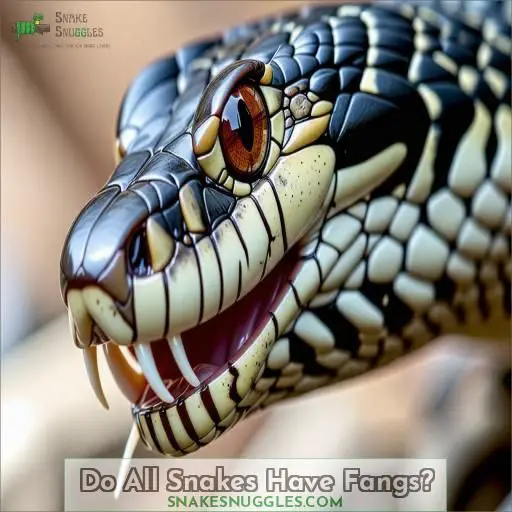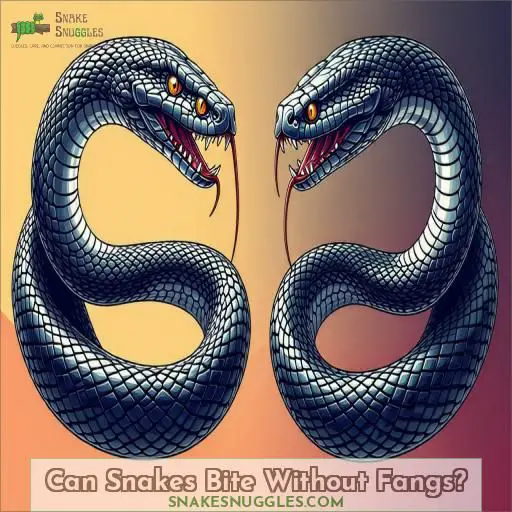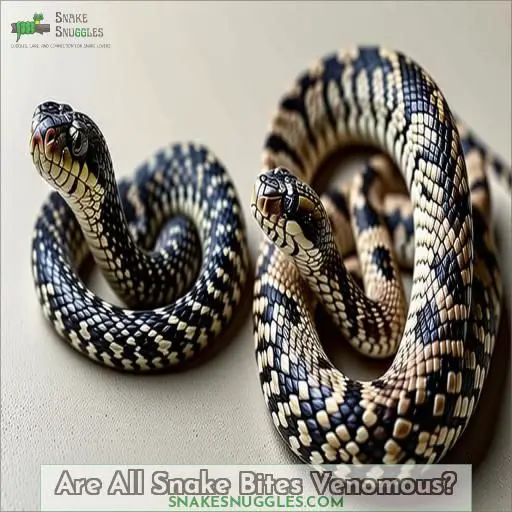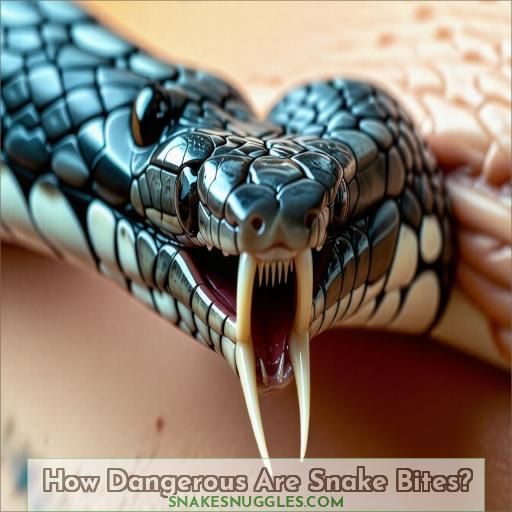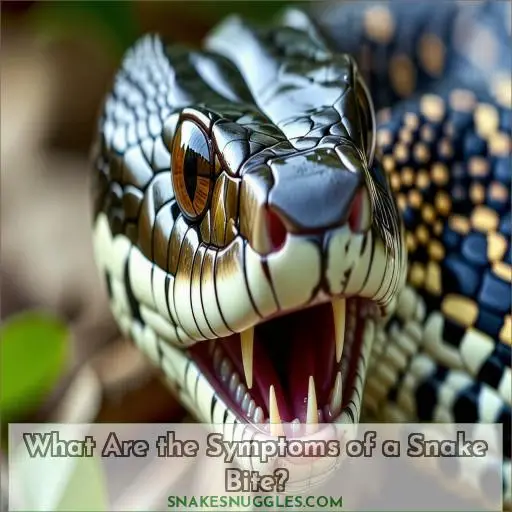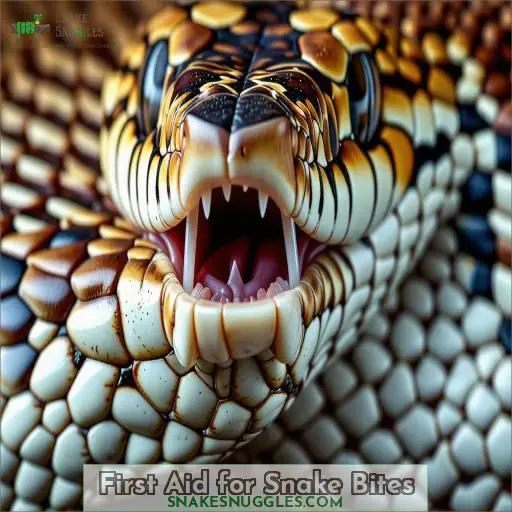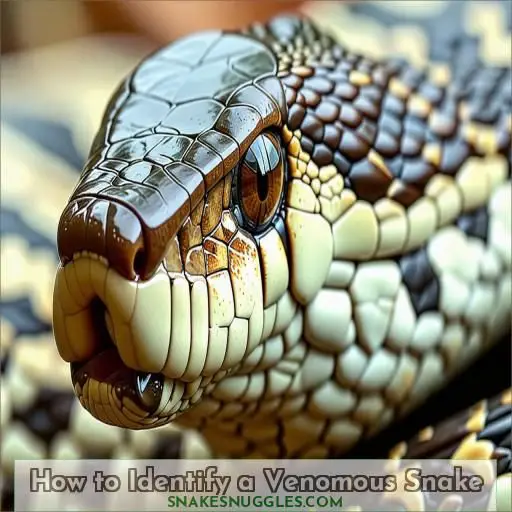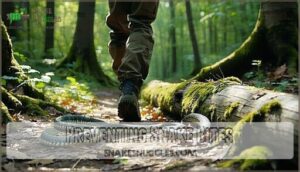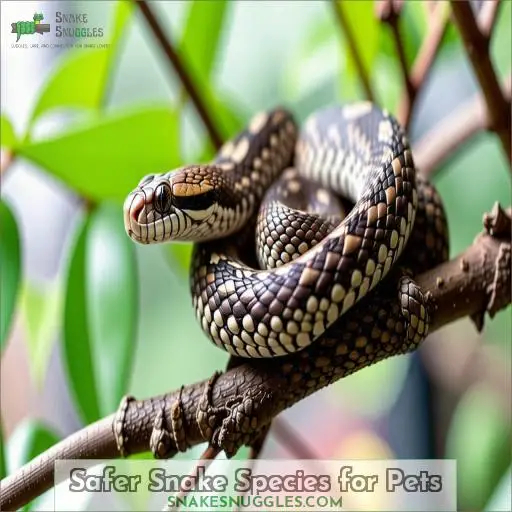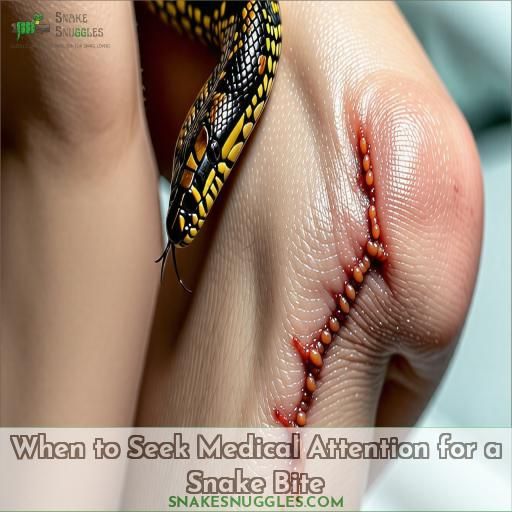This site is supported by our readers. We may earn a commission, at no cost to you, if you purchase through links.
1 No, not all snakes bite, though they’re certainly equipped to do so if threatened or defending themselves.
No, not all snakes bite, though they’re certainly equipped to do so if threatened or defending themselves.
Most snakes prefer to avoid confrontation and only bite as a last resort.
A key distinction is whether a snake is venomous – while their bites can still cause painful punctures, bites from non-venomous species aren’t life-threatening, though any bite risks infection.
Remain vigilant around snakes and let this overview serve as a precursor to learning how to identify venomous vs. non-venomous species, and proper first aid if one does strike.
Table Of Contents
- Key Takeaways
- Do All Snakes Bite?
- Do All Snakes Have Fangs?
- Can Snakes Bite Without Fangs?
- Are All Snake Bites Venomous?
- How Dangerous Are Snake Bites?
- What Are the Symptoms of a Snake Bite?
- First Aid for Snake Bites
- How to Identify a Venomous Snake
- Preventing Snake Bites
- Safer Snake Species for Pets
- When to Seek Medical Attention for a Snake Bite
- Frequently Asked Questions (FAQs)
- Conclusion
Key Takeaways
- Most snakes prefer to avoid confrontation and only bite as a last resort, but their bites can still cause painful punctures.
- Venomous snakes have specialized hollow fangs for injecting venom, while non-venomous snakes lack fangs and utilize constriction or large teeth to subdue prey.
- Identifying the snake species can help guide treatment, but it’s essential to treat every snake bite as potentially dangerous and seek immediate medical attention.
- To prevent snake bites, wear protective clothing, avoid handling snakes, and be cautious in snake habitats.
Do All Snakes Bite?
Yes, all snakes can bite, but not all snake bites are venomous. Snakes use their teeth to catch and swallow prey, and even non-venomous snakes have small teeth that can cause minor injuries. However, only about 20% of snake species are venomous, and their bites can be dangerous and require immediate medical attention.
Do All Snakes Have Fangs?
Snakes exhibit diverse dentition types.
While not all snakes possess fangs, venomous snakes have specialized fangs for injecting venom . These fangs are typically hollow or grooved, enabling venom delivery.
Nonvenomous snakes lack fangs and utilize constriction or large teeth to subdue prey .
The presence of fangs differentiates venomous and nonvenomous snake bites. Venomous bites result from fangs injecting venom, whereas nonvenomous bites don’t involve venom injection .
Consequently, it’s imperative to ascertain fang presence when dealing with snake bites to determine the appropriate medical response .
Understanding fangs is a pivotal aspect of distinguishing venomous and nonvenomous snake bites and is essential in providing targeted treatment and care, as knowing the proper snake bite first aid steps can significantly improve patient outcomes.
Can Snakes Bite Without Fangs?
While most snakes have teeth, not all of them have the long, hollow fangs associated with venomous species.
Non-venomous snakes, like corn snakes and king snakes, have small, solid teeth that are used for grasping and swallowing prey.
However, just because a snake lacks fangs doesn’t mean it can’t bite. Even without venom, a snake’s teeth can still cause painful puncture wounds.
To prevent bites, always approach snakes slowly, avoid hand-feeding, and never handle them roughly.
If bitten, clean the wound, apply pressure to stop bleeding, and seek medical attention.
Understanding snake behavior and respecting their space is key to avoiding harmful encounters.
Are All Snake Bites Venomous?
No, not all snake bites are venomous. In fact, most snake bites come from non-venomous species. However, it’s essential to treat every snake bite as potentially dangerous and seek immediate medical attention.
Here’s what you need to know about venomous vs. non-venomous snake bites:
- Venomous snakes have hollow fangs that inject venom, while non-venomous snakes have solid teeth.
- Venomous snakes often have triangular heads and elliptical pupils, but this isn’t always the case.
- Some non-venomous snakes mimic the appearance of venomous species for protection.
- Identifying the snake species can help guide treatment, but don’t risk getting bitten again to do so.
How Dangerous Are Snake Bites?
While snake bites can be alarming, it’s imperative to understand that they aren’t as dangerous as you might think. In fact, most snake bites in the United States are from non-venomous species and aren’t life-threatening. However, it’s still essential to seek medical attention for any snake bite, as even non-venomous bites can cause infection or allergic reactions. To reduce your risk of a dangerous snake bite:
- Wear protective clothing when hiking or working in areas where snakes live.
- Avoid handling snakes, even if you think they’re non-venomous.
- Be cautious around tall grass, rocks, and other areas where snakes may hide.
- If bitten, remain calm, immobilize the affected limb, and seek medical care promptly.
What Are the Symptoms of a Snake Bite?
If bitten by a venomous snake, you’ll likely experience intense pain and swelling at the bite site. Other worrying symptoms include nausea, vomiting, difficulty breathing, and even paralysis, which signal the venom’s neurotoxic effects and the need for immediate medical intervention.
Pain and Swelling
When bitten by a venomous snake like a copperhead, coral snake, cottonmouth, or rattlesnake, symptoms include pain, swelling, and potential venom injection. Immediate bite treatment involves cleaning the wound with soap and water, applying a pressure bandage, and seeking medical help for pain relief and swelling reduction. Remember, all snake bites should be taken seriously and treated promptly to minimize complications.
| Symptom | Treatment |
|---|---|
| Pain | Seek medical help |
| Swelling | Apply pressure bandage |
Nausea and Vomiting
Nausea and vomiting are common symptoms of a venomous snake bite. The venom can cause nausea, leading to vomiting. This is your body’s way of trying to expel the toxins. Seek immediate medical attention if you experience nausea or vomiting after a snake bite. Antivenoms and medications can help manage these symptoms and prevent complications.
- Nausea and vomiting are common snake bite symptoms
- Venom can cause nausea, leading to vomiting
- Your body tries to expel toxins through vomiting
- Seek medical help if you experience nausea or vomiting
Difficulty Breathing
When experiencing a snake bite, difficulty breathing is a severe symptom that requires immediate medical attention . Alongside pain and swelling at the bite site, and nausea and vomiting, difficulty breathing signifies a potentially venomous snake bite. This symptom may lead to respiratory failure if not promptly treated . Seeking medical help promptly is critical to address breathing difficulties and prevent further complications (Source).
| Venomous Snakes | Non-Venomous Snakes |
|---|---|
| Pit Vipers | Rat Snakes |
| Coral Snakes | Garter Snakes |
| Copperheads | King Snakes |
| Rattlesnakes | Corn Snakes |
Paralysis
Paralysis is a severe symptom of a venomous snake bite, causing muscle weakness or complete loss of movement. The paralysis can progress rapidly, affecting breathing and leading to respiratory failure if untreated. Seek immediate medical care if paralysis occurs after a bite, as it requires prompt treatment with antivenom to prevent complications like brain damage or death.
First Aid for Snake Bites
If bitten by a snake, you must remain calm and call for emergency medical assistance immediately. Immobilize the bitten limb, keeping it below heart level, then clean the wound with soap and water, and apply a pressure bandage to slow the spread of venom.
Remain Calm
Remain calm and take a few deep breaths.
Your emotional response is natural, but panic will only make the situation worse.
Anxiety and fear are common, but you must control them to provide proper first aid.
Staying composed is key to preventing further injury and ensuring the victim receives prompt medical attention.
Snakes may seem scary, but most common pet species like ball pythons and corn snakes are gentle rodent-eating reptiles that rarely bite.
Call for Emergency Help
Call emergency services immediately after a snake bite. Provide the dispatcher with your location and describe the snake if possible. Gather any first aid supplies like antiseptic wipes, bandages, and a compression bandage if available. Remain calm and reassure the victim while waiting for medical help to arrive. Avoid wasting time trying to capture the snake.
Immobilize the Limb
When dealing with a snake bite, immobilizing the affected limb is essential.
Secure the area with a pressure bandage and elevate it below heart level.
These measures help reduce the spread of venom through the lymphatic system.
Remember to stay calm and seek medical attention promptly.
Every moment counts and proper wound care and immobilization are critical before professional medical assistance is obtained.
Clean the Wound
Once the bitten limb is immobilized, it’s time to clean the wound.
Use soap and water to gently wash away any dirt or debris.
If the skin is broken and bleeding, flush the area with clean water to remove any venom.
Avoid using antiseptics or antibiotics at this stage, as they may cause further irritation.
Focus on keeping the wound clean to prevent infection until medical help arrives.
Apply Pressure Bandage
To apply a pressure bandage for a snake bite, use a wide crepe or elastic bandage.
Start at the bite site, wrapping firmly but not too tight, covering the entire limb.
Make sure the bandage extends above and below the bite area.
Don’t remove the bandage until medical help arrives.
It helps slow venom spread.
Remember to avoid cutting or sucking the wound .
How to Identify a Venomous Snake
To identify a venomous snake, look for key physical characteristics: a triangular-shaped head, elliptical pupils, and heat-sensing pits between the eyes and nostrils. When trying to distinguish between venomous and non-venomous species, check snake characteristics. These features, especially the heat pits which aid in detecting prey, are hallmarks of venomous snakes like rattlesnakes, copperheads, and coral snakes.
Triangular Head
One key way to identify a venomous snake is by its triangular-shaped head.
Venomous snakes have a distinct, wide, arrow-shaped head due to their venom glands located behind their eyes.
This head shape is an adaptation for venom injection through their hollow fangs.
However, some non-venomous snakes can mimic this appearance for defense.
Always exercise caution around any snake with a triangular head.
Elliptical Pupils
Venomous snakes often have elliptical pupils, unlike the round pupils of nonvenomous snakes. However, some nonvenomous species mimic this trait for protection. Pupil shape varies among snakes, with some having vertical, horizontal, or even irregular pupils. These eye adaptations help snakes see better in their environments and detect prey.
| Venomous Snakes | Nonvenomous Snakes |
|---|---|
| Elliptical pupils | Round pupils |
| Mimic venomous species | Variety of pupil shapes |
| Venom injection | No venom injection |
| Prey detection | Prey detection |
Heat-sensing Pits
The heat-sensing pits found in pit vipers are essential for their infrared detection of prey. These specialized facial pits allow them to sense the heat emitted by warm-blooded animals, aiding in hunting and survival. These organs provide pit vipers with a remarkable advantage in identifying and capturing prey, making them formidable predators in their natural habitats.
- Essential role in detecting infrared heat emitted by warm-blooded animals
- Aid in hunting and survival by providing a unique advantage
- Make pit vipers formidable predators in their natural habitats.
Preventing Snake Bites
To prevent snake bites, you should wear protective clothing like boots, long pants, and gloves when in areas with potential snake activity. Additionally, refrain from handling or attempting to catch snakes, as this greatly increases your risk of being bitten, even by non-venomous species.
Wear Protective Clothing
To avoid snake bites, wear protective clothing like snake-proof boots, long pants, and protective sleeves. Different clothing materials offer varying levels of protection. Snake gaiters are also an option for extra leg coverage. Dressing appropriately for snake country is essential for your safety. Stay vigilant and keep an eye out for slithering dangers.
| Clothing Item | Material | Protection Level |
|---|---|---|
| Snake-proof Boots | Leather, Rubber | High |
| Long Pants | Denim, Canvas | Moderate |
| Protective Sleeves | Leather, Canvas | Moderate |
Avoid Handling Snakes
Avoid handling snakes at all costs. It’s simply not worth the risks involved. Snakes can bite unexpectedly, even if they seem calm. Always use tools like hooks or tongs when working with pet snakes. Never hand-feed them, as this encourages biting. Respect their space and avoid unnecessary interactions. Safety should always come first when dealing with these fascinating creatures.
Be Cautious in Snake Habitats
When venturing into snake habitats, exercise caution. Wear protective footwear like thick boots or snake gaiters. Stick to well-traveled paths and avoid tall grass or dense underbrush where snakes may lurk. If you encounter a snake, slowly back away and give it space. Avoid approaching or handling snakes, even if they appear docile. Prioritize safety in snake country.
Safer Snake Species for Pets
If you’re looking for a relatively safe pet snake species, consider corn snakes, ball pythons, rosy boas, or California king snakes. These species are generally docile, less prone to biting, and their venom poses minimal threat to humans if accidentally bitten.
Corn Snakes
Corn snakes make excellent pets for beginners.
They’re docile, easy to handle, and have a lifespan of 15-20 years.
Provide a varied diet of appropriately-sized rodents.
Maintain a warm side (75-85°F) and cool side (70-75°F) in their enclosure.
Spot clean regularly and fully clean monthly.
Corn snakes are great for learning proper snake care and handling.
With their calm temperament, they’re a perfect choice for first-time snake owners.
Ball Pythons
Ball pythons are a popular choice for beginner snake owners due to their calm temperament and manageable size. These gentle giants make great pets with proper handling and care. Provide a spacious enclosure with hiding spots, maintain ideal temperatures, and feed a varied diet of appropriately sized rodents. With diligence, ball pythons can live 30-50 years in captivity.
Rosy Boas
When caring for Rosy Boas, consider their beautiful color variations, habitat preferences, and average lifespan in captivity.
These docile snakes are a safer pet option**, known for their gentle temperament.
Make sure to provide a suitable habitat with proper temperature and humidity levels.
Regular feeding and gentle handling are key for their well-being.
Following a thorough care routine will help ensure a long and healthy life for your Rosy Boa.
California King Snakes
California king snakes make excellent pets due to their gentle temperament and small size. They’re non-venomous and rarely bite. King snakes typically reach 3-5 feet in length and thrive in a variety of habitats. Their diet consists of rodents, birds, and other snakes. With proper care, California king snakes can live 15-20 years in captivity.
- California king snakes are known for their docile nature and rarely bite.
- They’re non-venomous and pose no threat to their owners.
- King snakes make great pets for beginners due to their small size and ease of care.
When to Seek Medical Attention for a Snake Bite
When a snake bite occurs, it’s vital to seek medical attention promptly. Regardless of the type of snake, all bites require professional evaluation (Source). Prompt medical assessment is necessary even if the snake is nonvenomous, as complications can still arise from the bite itself . Venomous snake bites are particularly dangerous due to the potential risks associated with different types of snake venom, such as neurotoxicity, tissue necrosis, coagulopathy, kidney failure, and respiratory failure . Snake bite severity can vary widely and is influenced by multiple risk factors, including the species of snake, the amount of venom injected, and the location of the bite . Prevalence of snake bites is highest in rural areas of Africa, Asia, and Latin America, with approximately 2.5 million venomous snake bites and 125,000 deaths occurring annually worldwide . Accordingly, recognizing the signs of snake bites and understanding the available treatment options is essential for ensuring the appropriate response to these emergencies .
| Signs of Snake Bite | First Aid Action |
|---|---|
| Pain and Swelling | Clean the wound with soap and water |
| Nausea and Vomiting | Seek immediate medical attention |
| Difficulty Breathing | Immobilize the bitten limb |
| Paralysis | Apply a pressure bandage to the wound |
Frequently Asked Questions (FAQs)
What kind of snake doesn’t bite?
Surprisingly, most snakes are non-venomous and rarely bite unless provoked. Some gentle species, like garter snakes and corn snakes, are docile and make excellent pets for experienced reptile enthusiasts.
Do harmless snakes bite?
Yes, even harmless non-venomous snakes can bite in self-defense or when threatened. But their bites typically cause only minor pain and swelling. Proper handling avoids unintentional bites from these generally docile snakes.
Can you train snakes not to bite?
You can’t fully train snakes not to bite, as biting is their natural defense mechanism. However, consistent positive reinforcement during handling can help reduce defensive biting over time.
How likely is a pet snake to bite you?
While most snakes are docile pets, the likelihood of getting bitten depends on the species and your handling skills. With proper care and respect for their instincts, bites are relatively uncommon but always a possibility.
Can snakes bite through thick clothing?
Even the thickest denim won’t stop a snake’s venomous fangs from piercing through. Those reptilian chompers can puncture sturdy leather like it’s paper—so dress wisely if handling slithery friends.
How long does snake venom last?
The effects of snake venom can last days to weeks depending on the species. You’ll need immediate medical treatment and antivenom to neutralize the venom’s toxic proteins.
What happens if a snake bites itself?
If a snake bites itself, it can suffer the effects of its own venom. The bite may cause swelling, bleeding, and potentially life-threatening symptoms that require immediate veterinary care.
Can snakes bite while sleeping?
With an hourglass figure, yes, snakes can strike while asleep—their reflexes are lightning quick. So handle them carefully, for even a dozing serpent may expel its venom-laced fangs if startled.
How do snakes choose their prey?
You’ll be amazed by how snakes select prey! They use incredible senses like heat-sensing pits to detect warm-blooded creatures from far away. Their flickering tongues also pick up chemical trails left by potential meals. It’s a perfectly adapted hunting strategy.
Conclusion
Much like the serpent in the garden, not all snakes bite, but caution is wise.
While most avoid confrontation, understanding venomous species and proper first aid prepares you should one do strike.


